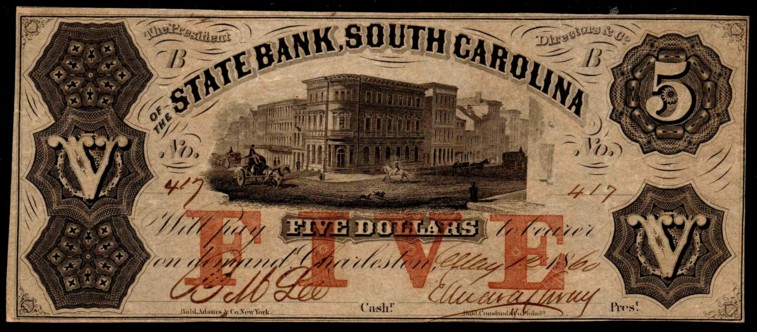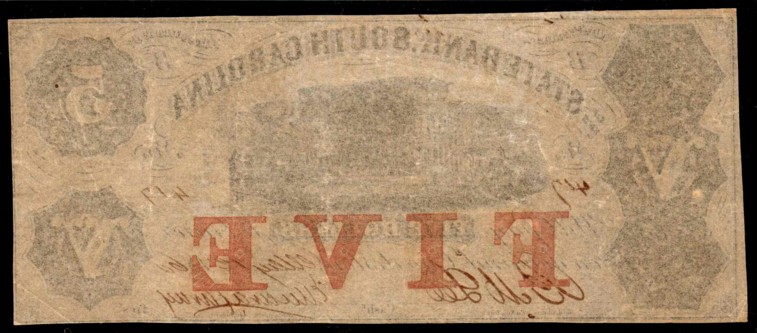South Carolina 1860 $5
State Bank of South Carolina, Charleston
The next note is dated May 1st 1860 and shows a central vignette of the State Bank of South Carolina, Charleston Branch. The building still stands today on the corner of Broad Street and E. Bay Street, looking almost exactly the same as the vignette.
Printed by Bald, Cousland & Company in Philadelphia, PA, the banknote is signed by Cashier B(enjamin) M. Lee and President Edward Sebring. The bank was in operation from 1801, but obtained its charter in 1802, and remained in operation until the end of the Civil War.
The Bank President, Edward Sebring, (b. July 26, 1799, d. June 30, 1880) Served as the president throughout the Civil War. When Sebring received word that General Sherman and his troops were drawing close towards Charleston, S.C., Sebring decided that it would be best to take the banks paper assets away to Camden, just to the north-west of Charleston. However, some of the Union troops wound up in Camden and discovered the money there, and made off with it.
To make matters worse for Sebring, the Union Army troops under General Potter ransacked Sebring’s home while he was away, stealing his valuable items and subjecting the home to vandalism.
The bank also had 100 bonds from before the Civil War, which were $1,000 bonds to aid the Blue Ridge Rail Road Company. While trying to hide the bonds from the marauding Union Army, the Banks Cashier, Benjamin M. Lee, was captured by Union Troops on February 27, 1865, near Lynch Creek, South Carolina (near modern day Lake City). All but four of the bonds were stolen by Union Army Troops. Bond numbers 812, 821, 836 and 837, were turned over to the U.S. Treasury, with another 39 bonds later recovered, and the remainder having been presumably destroyed.
This banknote was issued on May 1st, 1860. The preceding month, on April 3rd, saw the first run of the Pony express from Missouri to California. On May 18, 1860 Abraham Lincoln was chosen by the Republican Party to run for U.S. President. He would win the presidential election on November 6, 1860, the first Republican to win the presidency. Then, on December 20, 1860, South Carolina seceded from the Union, the first state to do so. Several southern states followed in secession, and in April 1861 Fort Sumter was attacked, and the Civil War began.

